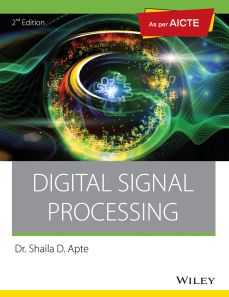Digital Signal Processing, 2ed, As per AICTE
ISBN: 9788126510733
For more information write to us at: acadmktg@wiley.com

Description
The scope of the book has been increased to cover the syllabi of DSP course all over India and to enhance the practical guidance in the book by including the MATLAB programs for teachers teaching the subject for the first time. The efforts are made to enhance the scope of the book to its fullest possible extent by and to include large number of MATLAB programs for the benefit of the reader. The book is intended to provide rigorous treatment of DSP at undergraduate level and will serve as a textbook for undergraduate studies and is designed to provide solid foundation for specialized courses in DSP.
Foreword
Preface to Second Edition
1 Fundamentals of DSP
1.1 Signals
1.2 Classification of Signals
1.3 Graph Terminology and Domains
1.4 DT Signals or Sequences
1.5 Signal Processing Operations
2 Sampling
2.1 Sampling Theorem
2.2 Sampling of Analog Signals (Case I)
2.3 Recovery of Analog Signals (Case I)
2.4 Sampling of Analog Signals (Case II)
2.5 Recovery of Analog Signals (Case II)
2.6 Analytical Treatment
2.7 Analytical Example
2.8 Anti-Aliasing Filter
3 Discrete Time Signals and Systems
3.1 DT Representation of Sinusoids
3.2 Some Standard DT Signals
3.3 Analog Signals
3.4 DT Signals
3.5 DT Systems
3.6 Properties of LTI Systems
4 Z Transform
4.1 Need for a Transform
4.2 Relation between Laplace Transform and Z Transform
4.3 Relation between Fourier Transform (FT) and Z Transform
4.4 Solved Problems on Z Transform
4.5 Properties of ROC
4.6 Properties of Z Transform
4.7 Relation between Pole Locations and Time Domain Behavior
4.8 Inverse Z Transform
4.9 Solution of Difference Equation using Z Transform
4.10 Applications of ZT and IZT
5 Discrete Fourier Transform
5.1 Sampling Theorem in Frequency Domain: DFT
5.2 Interpolation Formula for X(ω)
5.3 Relationship to Z Transform
5.4 DFT as a Linear Transformation
5.5 Properties of DFT
5.6 Circular Convolution and Its Implementation
5.7 Conversion of Linear Convolution to Circular Convolution
5.8 Efficient Computation of DFT
5.9 Linear Filtering using FFT
5.10 Goertzel Algorithm
5.11 Spectral Resolution and Selection of Window Length
5.12 Frequency Analysis of DT Signals
5.13 Power Spectral Density and Energy Spectral Density
5.14 Chirp Z Transform Algorithm
6 Linear Time-Invariant Filter Realization
6.1 FIR and IIR Systems
6.2 FIR System Structures
6.3 IIR System Structures
7 FIR Filter Design
7.1 Ideal Filter Requirements
7.2 Fourier Series Expansion Method
7.3 Use of Windowing
7.4 High-Pass and Band-Pass Filter Design
7.5 FIR Filter Design using Frequency Sampling Method
7.6 FIR Differentiator Design
7.7 Design of FIR Hilbert Transformer
7.8 Frequency Sampling Structures
7.9 Equiripple Design of FIR Filters – Alternation Theorem
7.10 Application of FIR Filter for Speech Processing
8 IIR Filter Design
8.1 IIR Filter Design using Method of Mapping of Differentials
8.2 IIR Filter Design using Impulse Invariance
8.3 IIR Filter Design using Bilinear Transformation
8.4 Analog Filters – Butterworth Filters
8.5 Analog Filters – Chebyshev Filters
8.6 Applications of IIR Filters
9 Quantization Effects in IIR Filters
9.1 Truncation and Rounding
9.2 Input Signal Sample Quantization
9.3 Coefficient Inaccuracy Error
9.4 Product Round-Off Error
9.5 Scaling Considerations
9.6 Limit Cycle Oscillations
10 Multirate DSP
10.1 Decimation by Integer Factor D
10.2 Interpolation by Integer Factor I
10.3 Sampling Rate Conversion by Factor I /D
10.4 Efficient Implementation of Decimator/Interpolator
10.5 Polyphase Filter Structures
10.6 Time Variant Filter Structures
10.7 Multistage Filter Design
10.8 Oversampling ADC/DAC
10.9 Sub-Band Coding of Speech Signals
11 Other Transforms
11.1 Basis Functions, Basis Matrix, Orthogonality and Reversibility
11.2 Energy Compaction
11.3 Decorrelation
11.4 DCT and DST
11.5 Karhunen–Loève Transform (KLT)
11.6 Applications of Different Transforms
12 Introduction to Wavelet Transform
12.1 Short-Time Fourier Transform (STFT)
12.2 Wavelet Transform
12.3 Haar Wavelet and Multiresolution Analysis
12.4 Daubechies Wavelets
12.5 Some Other Standard Wavelets
12.6 Applications of Wavelet Transform
13 Introduction to Digital Signal Processors
13.1 Digital Signal Processor Architecture
13.2 Multiple Access Memory and Multiport Memory
13.3 Circular Buffering
13.4 Fixed-Point and Floating-Point Representations
13.5 Case Study – TMS320C6713 (Texas Instruments)
13.6 Case Study – ADSP SHARC Processor (Analog Devices)
13.7 VLSI Architecture for DSP Algorithms
Summary
Key Terms
Multiple-Choice Questions
Review Questions
Answers
Appendix: Table of Z Transform Pairs
Frequently Asked Questions For Oral Examination
Frequently Asked Questions For Theory Examination
Index

